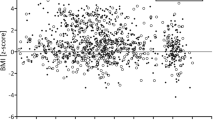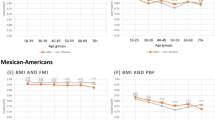Abstract
Objective: To study the relationship between body fat percent (BF%) and body mass index (BMI) in two different Indonesian ethnic groups (Malays and Chinese) and to relate differences in the relationship to differences in body build and slenderness.
Design: Cross-sectional study.
Subjects: Except for ethnicity, not specially selected populations living on Java (Depok, south of Jakarta: Malay Indonesians, n=117) and on Sulawesi (Makale, north of Ujung Pandang: Chinese Indonesians, n=109).
Measurements: Weight, height, sitting height, waist and hip circumferences and skeletal widths were measured. BMI was calculated and BF% was predicted from BMI, age and sex using a (Dutch) Caucasian prediction formula. Slenderness was expressed as the ratio of weight:sum of knee and wrist width. BF% assessed by deuterium oxide dilution was used as a reference.
Results: BF% in the male and female Malay Indonesians was 24.6±7.0 and 35.6±5.6% respectively which was not significantly different from the values in the male and female Chinese Indonesians (24.0±4.3 and 33.8±6.9%). BMI and age were significantly lower in the Malay Indonesians. Malay Indonesians had a more slender body build in terms of skeletal widths compared to the Chinese Indonesians, and they had a higher slenderness index. BF% predicted from BMI using a Caucasian prediction formula was underestimated by 5.8±4.8% and 7.7±3.8% in the male and female Malay Indonesians but only by 1.3±3.0% and 1.7±3.7% in the male and female Chinese Indonesians. After correction for differences in age, sex and BF% the Malay Indonesians had a 1.7±0.3 kg/m2 (P<0.0001) lower BMI than the Chinese Indonesians. After correcting for body build and relative sitting height the difference lowered to 0.9±0.4 kg/m2 (P<0.02).
Conclusions: The study confirmed the results of an earlier study that Indonesians have a higher BF% at the same BMI compared to Caucasians, but that there are apparently also differences among Indonesian subgroups. These differences are at least partly related to differences in body build.
This is a preview of subscription content, access via your institution
Access options
Subscribe to this journal
Receive 12 print issues and online access
$259.00 per year
only $21.58 per issue
Buy this article
- Purchase on Springer Link
- Instant access to full article PDF
Prices may be subject to local taxes which are calculated during checkout
Similar content being viewed by others
Author information
Authors and Affiliations
Contributions
GuarantorS Gurrici
Contributors: Organization of the study was done by Gurrici for the Indonesian part and by Deurenberg and Hautvast for the Dutch part. The practical measurements were performed by Gurrici, Hartriyanti and Deurenberg. Data analysis was done by Hartriyanti and Deurenberg. Paper writing and discussion was a joint effort of all four authors.
Corresponding author
Rights and permissions
About this article
Cite this article
Gurrici, S., Hartriyanti, Y., Hautvast, J. et al. Differences in the relationship between body fat and body mass index between two different Indonesian ethnic groups: The effect of body build. Eur J Clin Nutr 53, 468–472 (1999). https://doi.org/10.1038/sj.ejcn.1600778
Received:
Revised:
Accepted:
Published:
Issue Date:
DOI: https://doi.org/10.1038/sj.ejcn.1600778
Keywords
This article is cited by
-
Ethnic Specific body fat percent prediction equation as surrogate marker of obesity in Ethiopian adults
Journal of Health, Population and Nutrition (2021)
-
Diagnosing metabolic syndrome in a multi-ethnic country: is an ethnic-specific cut-off point of waist circumference needed?
Nutrition & Diabetes (2020)
-
Adjusting for BMI in analyses of volumetric mammographic density and breast cancer risk
Breast Cancer Research (2018)
-
Proposal of new body composition prediction equations from bioelectrical impedance for Indonesian men
European Journal of Clinical Nutrition (2016)
-
Prevalence of metabolic syndrome among urban community residents in China
BMC Public Health (2013)



